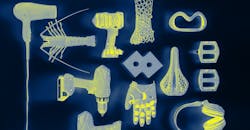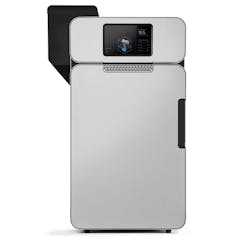Known for its stereolithography (SLA) process in the 3D-printing industry, Formlabs recently waded into new territory with the Fuse 1 printer, which leverages selective laser sintering (SLS). It plans to do the same for SLS as it did for SLA—deliver easy-to-use plug-and-play machines. To make that happen, though, the firm had to overcome several new challenges that arose when developing the Fuse 1.
Formlabs' Fuse 1 printer
To reduce cost and increase speed, the company uses a YAG fiber laser rather than a CO2 laser. The switch resulted in accuracy of up to one micron. However, there is one downside: Some YAG lasers are limited in material. Fortunately, Nylon 11 and 12 are great materials for prototypes and end-use parts (see table). Still, the YAG lasers’ small wavelength means that users must use black or dark nylon colors.
The machine’s ease of use and ability to print on a benchtop provide clear benefits; specifically, there’s no need for a massive shop space. Ultimately, the Fuse 1 should be successful in bringing SLS to a larger audience due to its user-friendliness. And with the price just under $10,000, it makes 3D printing much more affordable than some larger industrial printers.
Special features include a live video monitor that lets users see the part’s progress. The Fuse 1 also performs real-time inspection to ensure part quality. The SLS process is also convenient in terms of time—an important aspect in the world of 3D printing—because it works well for stacking or nesting parts.
As seen on display at MD&M East, the lobster (lower left) was built in one print. All of its joints move just like that of an actual lobster. The headphones (upper right) are pliable and strong. It was impressive to see how changing the design could make the same material stiff and rigid or flexible and springy.
Another time benefit is that Formlabs allows users to swap the entire build chamber to continue printing. One question remains, though: “How much does the chamber weigh?” When the chamber is empty, it may not be a problem. But removing the chamber filled with powder and parts might be difficult. On the plus side, if the chamber is too heavy, users could always 3D-print a solution.




